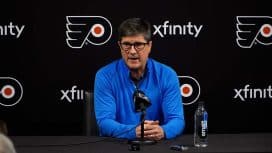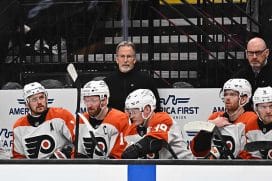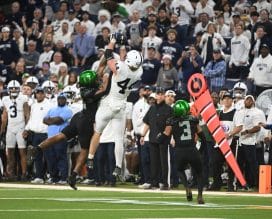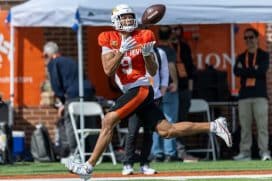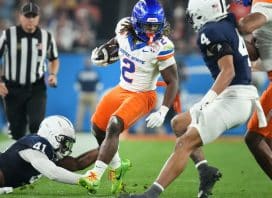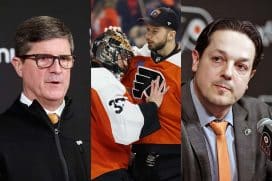Uncategorized
How Does Flyers Current Prospect Pool Compare to Past Groups?
Over the course of the last few years, the Philadelphia Flyers' farm system has gone from virtually barren — the after-effects of being strip-mined of high-end draft picks in "win now" drives — to one of the main reasons for long-term optimism. In particular, the pool of defense prospects has received considerable attention and hype after the Flyers have used three straight first-round picks on defensemen.
Some have gone so far to say that the current pool of defense prospects may be the best in franchise history in terms of players with high-end upside, overall depth and diversity of skill-sets and potential roles at the NHL level. As a group, they can all skate well and have good puck skills. The forward pool — while rather undersized on the whole — has skill, speed and character. In the meantime, the 2015 Draft saw the Flyers select three goaltenders in an effort to achieve some depth in the game's most difficult-to-project position.
While only time will tell how the current group ultimately stacks up at the NHL against Flyers prospect pools of the past, it is fair to say that the bar is set pretty high if the current group is to some day rank among the best collections of young talent the organization has assembled.
Working backwards chronologically, here is a look at the historical periods at which the Flyers' farm system was at its deepest.
2004-05 Phantoms Calder Cup team: During the locked-out and ultimately canceled NHL season, the American Hockey League became the top league in North America. Bolstered by the end-of-season additions of 2003 first-round picks Jeff Carter and Mike Richards, the Philadelphia Phantoms won the Calder Cup. While those two players received the most attention at the time, a glance at the team's roster shows that the Flyers' top affiliate was stacked with impressive talent.
Apart from Carter and Richards, the 2004-05 Phantoms forward corps featured the likes of rookie R.J. Umberger (who led the team in scoring in the regular season and then chipped in 10 playoff points in more of a supporting role) and 22-year-old third-season pro Patrick Sharp (22 goals, 52 points in the regular season, 21 points in 21 playoff games). Adding depth and toughness were players such as former Phoenix Coyotes first-round pick Ben Eager.
On the blueline, the Phantoms featured the fourth overall pick of the 2002 NHL Draft, Joni Pitkänen. In his second season of pro hockey in North American, Pitkänen (who had spent the previous full season in the NHL with the Flyers) was assigned to the AHL due to the lockout. While Pitkänen had a somewhat inconsistent regular season, he elevated his game down the stretch and during the playoffs.
The most consistent of the young Phantoms defensemen at the time was 23-year-old Dennis Seidenberg. Then in his third season in North America, Seidenberg started to come into his own both defensively (penalty killing, blocking shots) and offensively (13 goals, 41 points in the regular season, 10 points in the playoffs).
At the time, Flyers 2003 third-round pick Alexandre Picard was considered a quick-rising NHL prospect with good size, puck skills and poise under pressure. He joined the Phantoms for two playoff games and held his own. Two other, undrafted young Phantoms defensemen in the supporting cast would also later go on to play in the NHL for a time: Randy Jones and the severely undersized by savvy and skilled Freddy Meyer.
In goal, Finnish netminder Antero Niittymäki established himself as an AHL-level star and a solid NHL prospect after an excellent regular season and a spectacular playoff run that saw him win the Jack Butterfield Trophy (the AHL equivalent of the Conn Smythe Trophy). Although his subsequent NHL career was derailed by chronic hip injuries — necessitating hip replacement surgery by the time he was 32 years old — Niittymäki had an outstanding career at every level except the NHL. He won three straight championships (two as a starter) and a Rookie of the Year award in Finland before coming to North America, the Calder Cup and Butterfield Trophy as the Phantoms starter and the 2006 Olympic MVP award while playing among the best players in the world.
Taken on the whole, the collection of NHL prospects the Flyers assembled on that 2004-05 championship team at the AHL level holds as the gold standard in team history within the last 20 years.
Russ Farwell era (1990 to 1994): The tenure of former Flyers general manager is not a fondly remembered period in team history. The club missed the playoffs for the duration of his stewardship and then turned things around at the NHL level in the lockout-shortened 1994-95 season; the first year of Bob Clarke's second stint.
Keep in mind, however, that Farwell was basically starting from scratch. He inherited a team that had already been depleted at the NHL level by injuries (Mark Howe, Tim Kerr, Ron Hextall's frequent groin pulls) and trades of key players (Brad McCrimmon, Brian Propp, Dave Poulin) that did not yield much of anything in return for the Flyers. In the meantime, the once-mighty farm system was virtually desolate after a series of bad drafts.
While the Flyers had little on-ice success during the Farwell years, the general manager and a somewhat reconfigured group of scouts had plenty of success in drafting.
Farwell may not have made the best possible first pick in 1990, selecting the certainty of Mike Ricci's gritty two-way play a over the then-uncertainty of the more offensively skilled Jaromir Jagr's immediate NHL availability and adaptation to the small rink. However, there was nothing inherently wrong with Ricci. He was by no means a bust; just not a once-in-a-lifetime superstar like Jagr turned out to be.
At their core, drafts are about depth. A quick glance at the Flyers' 1990 draft pool shows that, round after round, the Flyers did a good job at finding potential future NHLers of different roles and positions. After the Ricci pick at fourth overall, the Flyers took tough winger Chris Simon (25th overall), skilled and hard-working Swedish winger Mikael Renberg (40th overall), big-framed but mobile defenseman Chris Therien (47th overall), hard-nosed Dan Kordic (then a defenseman but later a forward, 88th overall), a fast-rising young CSKA Moscow center named Vycheslav Butsayev (109th overall), and acrobatic little Swedish goaltender Tommy Söderström (214th overall).
Although Butsayev did not make much of an NHL impact when he arrived in North America, his stock rose quickly after the 1990 Draft; just as high if not even a tad higher than Renberg's stock in the years immediately following the Draft. Both were considered high end prospects by the time they came over to the NHL. The only difference is that one (Renberg) made good on his potential and the other did not.
Likewise, Kimbi Daniels (selected 44th overall by the Flyers in the 1990 Draft) did not do much once he got to the pro level. He only wound up playing eight NHL games. However, he entered the NHL with a lot of hype about his scoring potential along with some off-ice behavioral concerns. In his "prospect years" from his draft year into his early 20s, Daniels was considered a high-yield if high-risk player to add to the system.
Finally, big defensive defenseman Terran Sandwith (taken 42nd overall) was, for a time, considered at least a potential future third-pairing defensemen at the NHL level. He ended up basically a career minor-league player but did play in eight NHL games with Edmonton after leaving the Flyers organization.
By any estimation, Farwell's first draft as Flyers general manager proved to be a pretty big step toward restocking to prospect cupboard. His second draft would be another impressive one.
With the sixth overall pick of the 1991 NHL Draft, the Flyers shocked many observers by taking Swedish center Peter Forsberg — ranked by most sources as a likely late first-rounder or even an early second-round pick. The pick was immediately panned as a "reach" but Forsberg's rocket-like ascent thereafter showed that the Flyers knew the future Hall of Famer was something special before most everyone else realized it.
The Flyers chose a pair of Russians in the 1991 draft — teenage defenseman Dmitri Yushkevich (122nd overall) and veteran two-way winger Andrei Lomakin (138th overall). Yushkevich went on to become a solid NHL defenseman for many years, while the late Lomakin was a decent role player.
Elsewhere in the 1991 draft, the Flyers chose speedy QMJHL winger Yanick Dupre with the 50th overall pick. Dupre briefly cracked the Flyers' roster right out of his first training camp before settling into a more prolonged development cycle. He seemed to have a future as a third-line NHL winger when his career — and ultimately his life — was tragically ended after a brave battle against leukemia.
Finally, longtime Phantoms goaltender and periodic Flyers backup Neil Little was also a product of the Flyers' crop of picks from the 1991 draft. He was a member of both Phantoms teams that won the Calder Cup (1997-98 and 2004-05) and the primary playoff goalie for the first.
In 1992, when the Flyers traded with the Quebec Nordiques for the rights to Eric Lindros — the holdout first-overall pick of the 1991 Draft — it came at an enormous cost. The assets included in the final trade package included Forsberg, Ricci, Simon and the Flyers' first-round picks in both the 1993 and 1994 NHL Drafts.
On the one hand, the trade took a big bite out of the depth the organization had spent the previous two years years rebuilding. On the other hand, the deal reeled in a projected once-in-a-generation franchise talent who would live up to that billing when healthy. With the previous trade acquisitions of established young NHL forwards Mark Recchi and Rod Brind'Amour, the Flyers now had a forward nucleus in place but still needed to work on building around them especially with a suspect blueline and inexperienced goaltending entrusted to Dominic Roussel and the impending arrival of Söderström.
The 1992 NHL Draft was a so-so one leaguewide and a particularly weak one for the Flyers that added little to the pro prospect pipeline. For a variety of reasons, first-round picks Ryan Sittler and Jason Bowen failed to make impacts upon turning pro. Fifth-round pick Vladislav Boulin was considered a bona fide NHL prospect for a time as a defensive defenseman but he wrecked a knee during his AHL career and lost too much off his skating.
In 1993, Farwell's Flyers rebounded to have another strong draft despite the lack of a first-round pick. Selected with the 36th overall pick, defenseman Janne Niinimaa went on to become a very highly touted prospect who enjoyed considerable early career success before falling a bit short of lofty expectations raised by his early promise. In his prospect years, however, Niinimaa was considered an outstanding candidate to become an NHL impact player.
With the 71st and 77th overall picks of the 1993 Draft, Farwell took a pair of Czechs. First, he selected a rail-thin playmaking center named Vaclav Prospal (who went on to play over 1,000 NHL games including a pair of stints with the Flyers). Prospal needed to add a lot of weight and work on his skating but it soon became clear his puck skills were outstanding.
Six spots later, the Flyers chose offensive defenseman Milos Holan. A prospect somewhat akin to current Flyers hopeful Shayne Gostisbehere, Holan was a run-and-gun smallish defenseman with a fearsome shot that he was not the least bit shy to unleash. Holan, who was later traded to Anaheim and survived a bout with leukemia to resume his hockey career, wound up playing in 49 career NHL games.
With the 140th overall pick, the Flyers took another small offensive defenseman, Mike Crowley. The University of Minnesota product was no longer in the Flyers organization by the time he turned pro but he eventually played 67 NHL games for Anaheim (five goals, 20 points). Lastly, the Flyers took Western Hockey League winger Paul Healey (192nd overall), who went on to become a solid AHL player for the Phantoms, broke into the NHL with the Flyers and eventually played a total of 77 NHL regular season games for four teams.
Farwell was fired as general manager shortly before the 1994 Draft but stayed on briefly to complete draft preparations due to the lack of lead time for the newly rehired Clarke (who left the Florida Panthers' GM post to return to Philadelphia). Although Clarke was at the helm by the time the draft rolled around, the scouting staff was still the same.
Although not a stellar crop in hindsight and lacking both first-round and second-round selections, the 1994 Flyers draftees included some interesting talents. The team's first pick, Artem Anisimov (62nd overall), was rated as a four-star prospect in the 1995 Hockey News Draft Preview issue; along with Niinimaa, he was one of two four-star prospects in the system according to THN. Anisimov (not to be confused with the current NHL forward of the same name) was considered a shutdown defenseman and an intimidating — if not always clean — hitter in the same fashion as established NHLer Darius Kasparaitis.
Unfortunately, in an early season Russian Super League game in 1996, Anisimov suffered a devastating knee injury, tearing both his anterior cruciate ligament and medial collateral ligament simultaneously. He missed a full year and was never close to the same caliber player again despite resuming his career and playing overseas until 2008.
Selected with the 166th overall pick, Colin Forbes went on to become a solid AHLer with the Phantoms –a big and rugged power forward — and also cracked the Flyers starting lineup for a time. He went to have a 311-game NHL career with five clubs.
Russian winger Alexander Selivanov, selected 140th overall, was quickly flipped to the Tampa Bay Lighting (with future father-in-law Phil Esposito as its GM). He played 459 NHL games with the Lightning and Edmonton Oilers, including a 31-goal season in 1995-96 and a pair of goals in Tampa's first-round playoff series against the Flyers.
Taken 202nd overall, Yale University defenseman Ray Giroux came along at the wrong time. A Hobey Baker Award finalist his final year before turning pro, Giroux was a good puck-mover and reliable defender but had the misfortune of being considered undersized in an era where NHL teams looked for bigger and bigger defensemen. The Flyers traded his right to the Islanders, and Giroux excelled in both the AHL and KHL but got into just 38 NHL games with the Islanders and New Jersey Devils. Even so, that is not a bad return on a player taken so late in the Draft.
Likewise, 218th overall pick Johan Hedberg never played a professional game in the Flyers organization but had a long and reasonably successful career. Rejected by the Flyers due to what were perceived as excessive contract demands by his agent, Hedberg was traded to the San Jose Sharks organization and bounced around the minor leagues before finally cracking the NHL with the Pittsburgh Penguins in 2000-01. He went on to a lengthy career as a backup or split-time starter with several organizations, finally retiring officially in 2014.
Mid-1980s Flyers: If the mid-1970s were the golden era of Flyers hockey, the mid-1980s were the silver era. The teams coached by Mike Keenan were built on the strength of astute drafting (and free agent signings of undrafted prospects) by former general managers Keith Allen, Bob McCammon and a long-tenured group of scouts.
The Flyers' 1982 and 1983 Drafts were especially good ones in franchise history; ones that quickly produced an array of bonafide NHL prospects by the team Keenan took over the youngest team in the NHL in 1984-85 and led to the best regular season record in the league and a trip to the Stanley Cup Finals.
In 1982, the Flyers took gritty two-way forward Ron Sutter with the fourth overall pick (and acquired his twin brother, Penguins' 1982 first-pick Rich Sutter,the following year). Veteran international tournament defense star Miroslav "Cookie" Dvorak was taken in the third round after receiving permission from the communist Czechoslovakian government to leave for the NHL in exchange for a transfer fee.
In the sixth-round, the Flyers took a goaltender from Manitoba with outstanding puckhandling skills, an explosive on-ice temper and an excellent hockey pedigree as a third-generation player. His name: Ron Hextall.
Elsewhere in the 1982 draft, the Flyers took enigmatic but gifted forward Todd Bergen (who retired from hockey in his early 20s to pursue a golf career and because he disliked playing for Keenan). Bergen holds the odd distinction of owning the highest points-per-game average — 11 goals, 16 points in 14 regular season games for the Flyers in 1984-85 plus 13 points in 17 playoff games — among all-time players with fewer than 20 career NHL games.
With the 140th overall pick, the Flyers took enforcer Dave Brown. The big winger went on to become one of the NHL's most feared — and, ultimately, respected — tough guys for a decade.
The next year, despite the lack of a first-round pick, the Flyers got a bumper crop of future NHL impact players, including Peter Zezel (41st overall), Rick Tocchet (121st overall), and Per-Erik "Pelle" Eklund (161st overall). Additionally, longtime role player Derrick Smith (44th overall) was a product of the Flyers' 1993 draft. In 1994, the Flyers took long-tenured NHL power forward Scott Mellanby with a second-round pick.
Many of these players — along with still-young players such as 1979 first-round pick Brian Propp, 1979 second-rounder Pelle Lindbergh and rookie free agent signings Tim Kerr, Ilkka Sinisalo and mid-1980s team captain Dave Poulin — comprised the nucleus of the Keenan teams that reached the Finals twice in three years. Both Lindbergh and Hextall won Vezina Trophies in that span.
The rest of the nucleus was built through trades: young forward Murray Craven, defensemen Brad McCrimmon and Hall of Fame defenseman Mark Howe just as he was ready to hit his prime in the NHL.
The 1969 and 1972 Drafts: Along with the brilliant coaching of Fred Shero, astute trades by Allen and the goaltending of Bernie Parent, the Flyers' Stanley Cup championships of 1974 and 1975 and run of three straight trips to the Finals was built largely on Allen and the Flyers scouts striking gold in the 1969 and 1972 Drafts.
The 1969 Draft produced second-round pick Bobby Clarke (17th overall); already the reigning Hart Trophy winner heading into the 1973-74 season. Later, the Flyers selected future Broad Street Bully tough guys Dave Schultz (52nd overall) and Don Saleski (64th overall).
While no draft pick — or player acquired by any means — was more important to Flyers' history than Clarke, the 1972 Draft was still vitally important to the construction of the team. Future Hall of Fame left winger Bill Barber was the seventh overall pick of that draft year. Meanwhile, the Flyers added two fast-rising young defensemen — Jimmy Watson (39th overall, a future five-time NHL All-Star) and offensive-minded Tom Bladon (23rd overall) — who became mainstays on the blueline.
The Flyers also took forward Al MacAdam (55th overall) in 1972. In 1974, the prospect became the key to acquiring Reggie Leach from the California Seals. MacAdam enjoyed a fine NHL career in his own right, including a 42-goal, 93-point season in an 864-game career.
Bill Meltzer is a columnist for Flyerdelphia. Follow him on Twitter @billmeltzer.
